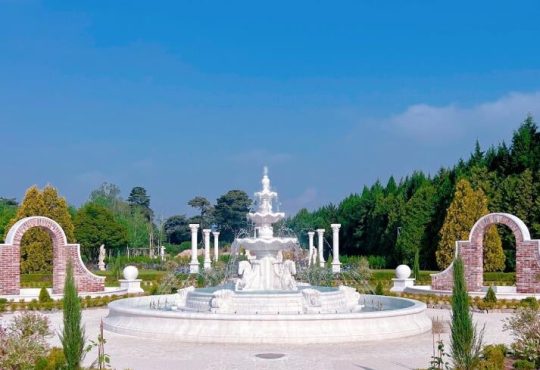Some artists paint what they see. Others like Luis Eduardo Rincon paint what they have lived, dreamed, and survived. With brush in hand and heart on canvas, Rincon’s story is one of constant movement between places, ideas, and moments in history. His life’s journey from Aguachica to Santa Marta, from Bogota to St Petersburg, reflects a restless soul guided by purpose and passion.
Luis Eduardo Rincon can only be defined in one way: an artist in every sense of the word. Born in Aguachica, Cesar resides in Santa Marta. Guided by his nomadic spirit, he has travelled the world, nurturing his work and exhibiting it in various venues that have made him a globetrotter —a man with potential whose name is destined to gain increasing recognition.
Born during the period known in Colombia as La Violencia, he was compelled by circumstance to journey across the country with his family in search of tranquillity. Over time, this constant movement between places became a defining characteristic of his life and work.
He asserts that his painting focuses on life, which he defines as the set of sensations, feelings, emotions, and death. The move to Santa Marta was driven by a desire to live beside the sea, in search of a contrasting landscape that captivates those who grew up in the Andean region.
Beginnings When Crayons Meet Calling
Rincon’s story as an artist begins where many great stories do, at home as a child with crayons and big ideas. Just like his daughter, who today has crayons decorating every wall in the house, Luis was the creative one of his family, and the walls were his first canvas.
At the age of four, his love and skill for painting played a trick on him. He never missed an opportunity to draw on any surface. His notebook seemed ideal for a couple of drawings, but his teacher, to correct his behaviour, put him in front of the class and showed all his classmates the drawings. As if that were not enough, she gave him the nickname Luis Matachin.
Today, he remembers it with joy and believes it may have been a life-changing move that made him question his calling, a calling he maintains is strong and will not be affected by what anyone else says or thinks. Painting, he explains, is a necessity—a force that continually draws him back, even after periods of distance. It remains an essential means of expression, an impulse that cannot be ignored.
A Craft Sharpened Through Mentorship
Rincon’s raw talent was matched by a hunger to learn, and fate, along with a proud mother, led him to his first mentor. From a young age, his talent was evident, but his knowledge was a product of experience. When he arrived in Bogota, he found guidance in the master painter Omar Gordillo, a Colombian born in Neiva.
He arrived at his workshop by chance because his proud mother showed them all his strokes. She took him to a veterinarian friend, who recommended introducing him to drawing. For this, they visited the workshop of the master Gordillo, who gave them valuable instructions over two years.
To continue his training, he later joined the studio of Franklin Ramos, a renowned teacher of fine arts, also born in Cesar. He recalls that amid the hustle and bustle of his job as a delivery boy for a store and a spare-time painter, he met a young woman who invited him to her apartment. Moved by the beauty of a woman posing nude, he followed her without question. She did not seduce him but instead offered him a greater reward. She took him to Ramos, who proposed that he become his assistant.
This workshop influenced his career. He learned oil painting and other techniques. From then on, his curiosity took over. He began visiting exhibitions and gathering inspiration and materials to develop his talent. He has been painting for 35 years since childhood, and has been professionally painting since he was 16.
Exhibiting Emotion and Memory
Maturity brought milestones, including exhibitions that would elevate his art into social dialogue. With maturity as an artist came his first exhibitions, the most significant being an illustration of a text about impunity and memory. The writer became interested in his art, considering that his close experiences with violence during his childhood would make him more sensitive to what he wanted to propose, and this work became his beginning. His next significant achievement came when he exhibited his works in the Boyaca Hall of the Congress of the Republic. It was the second time he saw the fruit of his talent transformed into something worthy of admiration.
True to his life as a constant traveller, he arrived in Ecuador, where he exhibited again and gained the knowledge to manage the spaces where his works could be displayed. But his first solo exhibition, the one that still lights up his eyes when he recounts it, took place in 2016 in Russia.
Making Waves in St Petersburg
Russia became a turning point for Rincon both professionally and personally. St. Petersburg hosted the first exhibition, The Gallery of Battles, which depicted five historical events: the Battle of Gaira, the Siege of Cartagena, the Last Battle of the Inca Empire against the Spanish, and the death of Gregory Rasputin—an element that drew notable attention from the Russian media.
Media attention was unexpected, as recognition in Colombia had yet to come. The initial goals upon arriving in the country were simply exposure and the opportunity to explore it, yet the experience yielded far more, bringing both connection and unexpected acclaim. Media attention was surprising, as recognition in Colombia had yet to come. The initial goals upon arriving in the country were simply exposure and the opportunity to explore it, yet the experience yielded far more, bringing both connection and unexpected acclaim.
For this exhibition, research into the Battle of Gaira led to a depiction that broke from traditional portrayals. Instead of the usual scenes of a naval clash, it was reimagined as a land battle, where the Tayrona Indigenous people ambushed Spaniards coming ashore in search of firewood, water, and food.
This work opened a massive door for her; she is already working on her next exhibition in St Petersburg, which will feature the only two female pirates on record. She faces a challenge to illustrate La Guajira and the Wayuu culture for an exhibition at the World Health Organisation office in Moscow.
The Caribbean Where Art Meets the Sea
For Rincon, the sea is more than scenery; it is a source of energy and confrontation, a muse that never stays still.
His relationship with the sea is extrasensory. He is convinced that it is better to live by the sea. He describes it as a great animal that covers the earth. They are united, but they constantly fight in a confrontation that can be felt in the waves that surge on the beach. It is described as a collision between two worlds.
He mentions that among his favourite places in Santa Marta are the beaches such as Inca Inca, La Bahia, and El Rodadero. He affirms that the city’s architectural richness seduces him, as demonstrated by his works on Santa Marta’s urban planning. He argues that textures and the transition from hydrated green landscapes to brown or desert textures are a constant source of inspiration for artists to create.
The Caribbean captivates with the magic the sea impresses upon the landscape, offering something unique at every vantage point. He believes that cultural expressions are the richest things to export, as they convey the emotion that champeta generates in foreigners. This is an exciting expression.
A New Generation of Artists in Santa Marta
Never one to keep knowledge to himself, Rincon has created a unique artistic space that champions both technique and expression.
In Santa Marta, he has already entered the world of artists with his proposal for a free workshop in which artists are invited to draw, paint, or write about the human figure. He seeks out models, most of whom learn to pose nude, and the artists learn to draw with the live human figure.
This creates a unique space that does not exist here, and models are trained to be live models. It is difficult to pose nude; the model must overcome moral prejudice while the painter passes a technical test. The workshop is held on Thursdays at the Magdalena Cultural Centre, he said.
Although the competition is open to both men and women, more women are taking on the challenge. The competition is small, but she hopes to continue growing so she can contribute her knowledge to the culture of Santa Marta.
Luis Eduardo Rincon: A Life Painted in Motion
Luis Eduardo Rincon is a creator, a teacher, a traveller, and most of all, a storyteller whose tools are pigment and perspective. His life and work reflect a Colombia that is constantly reimagining itself, a land of contradictions, resilience, and renewal. And as Rincon continues to move across borders and eras with his art, one thing remains clear: his story, like his canvas, is still unfolding, stroke by stroke, step by step. Rincón’s art has traced a path from the lively pulse of Colombia’s streets to the refined halls of Russia and Spain, carrying his vision far past its point of origin.



